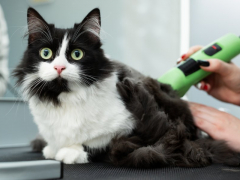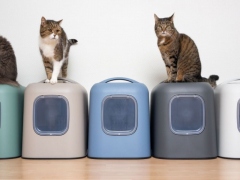
Andrzej Puchta / Shutterstock.com
An outbreak of the highly pathogenic avian influenza virus (H5N1) in dairy cattle occurred in the U.S. in March 2024. Since then, multiple smaller outbreaks in cats have been reported, including both indoor pet cats and outdoor feral cats.
Cats appear to be vulnerable to this virus, with many cases sadly linked to fatalities, so being alert to the signs that your cat might have the bird flu virus, and understanding how cats become infected is really important.
How Do Cats Catch Bird Flu?

Eating raw meat or unpasteurized milk has been linked to bird flu. Leka Sergeeva / Shutterstock.com
The American Veterinary Medical Association (AVMA) lists the known causes of transmission of the avian influenza virus to cats. The known routes of transmission include:
- Unpasteurized dairy products or colostrum
- Raw or undercooked meat
- Exposure to wild birds or poultry (including backyard chickens, turkeys and ducks)
- Exposure to people (or their clothing) who work on affected farms (including with dairy cows)
Although these outbreaks are scary to those of us who own and love cats, knowing how cats can catch bird flu helps us know what to consider to help prevent infection.
Disease control strategies being recommended by health officials for the prevention of bird flu in cats therefore include:
- Avoiding feeding raw meat and unpasteurized milk to cats (including raw pet food diets)
- Keep cats indoors to avoid exposure to wild birds
- Keep cats away from livestock, poultry and their associated housing
- Observe good hygiene, especially if you have been in contact with livestock, poultry or wild birds
5 Signs Your Cats Might Have the Bird Flu Virus

Discharge from the nose can be a sign of avian influenza in cats. Kyliki / Shutterstock.com
Infection with the avian influenza virus is still very uncommon in cats, but being aware of potential symptoms is still important for cat owners.
Here are the main signs of bird flu in cats to look out for:
1. General Signs of Illness
The first signs of avian influenza in cats are often fairly vague and non-specific. These might include a loss of appetite, lethargy and seeming quieter than usual, and a fever. Affected cats may hide away more, stop playing, and seem withdrawn.
If your cat is showing any of these signs then a check-up with a veterinarian is recommended, but don’t panic – these are common symptoms of many viruses and other illnesses in cats.
2. Rapid Progression of Illness
As the infection progresses, the cat’s fatigue may worsen into severe depression, and these more general signs of illness will quickly progress to more severe and specific symptoms.
3. Neurological Signs
More specific symptoms of bird flu in cats include neurological signs such as ataxia (poor muscle control causing wobbly, disorientated walking) and circling behaviors. It may look like your cat is feeling dizzy. These neurological signs can quickly progress to blindness, as well as muscle tremors and then seizures.
4. Fluid Discharge
A common sign of bird flu in cats appears to be a discharge from the eyes and nose. This stream of bodily fluids can be very heavy, and your cat’s eyes may look red and sore as well.
5. Respiratory Signs
The bird flu virus can also cause the classic ‘flu’ symptoms in our pets, such as coughing and sneezing. Affected cats may be breathing very fast or heavily, or begin to struggle to breathe.
What To Do if You Think Your Cat Has Bird Flu

Keeping cats away from any contact with birds is one way to reduce the likelihood of infection. Evgeniy Medvedev / Shutterstock.com
Bird flu in cats is still considered rare, so if your cat is unwell, it is more likely that they have another illness, such as feline herpesvirus or feline calicivirus (known together as cat flu). However, all cat owners should be vigilant whilst these outbreaks are ongoing, so here’s what to do if you’re concerned.
- Call your veterinarian: your vet should be the first contact, but give them advance warning about what you suspect. They may want to know more about your cat’s symptoms and may arrange specific hygiene precautions in advance.
- Limit contact: keep your cat quiet and away from as many people and other pets as possible, especially if there are any immunocompromised individuals in the household.
- Maintain hygiene: wash hands thoroughly before and after handling a sick cat, to minimise transmission of any infectious particles.







